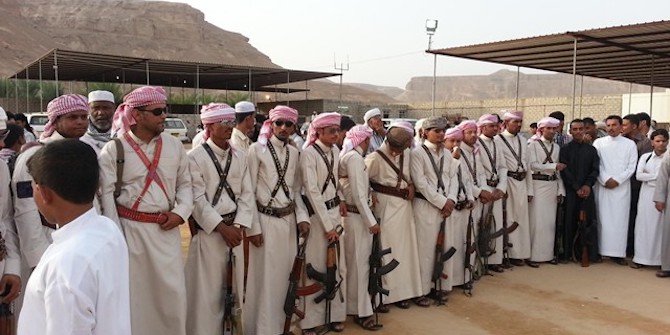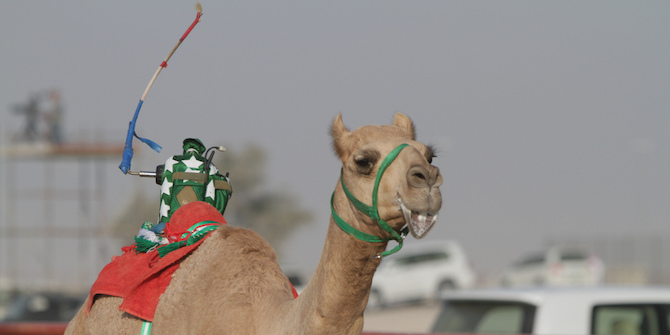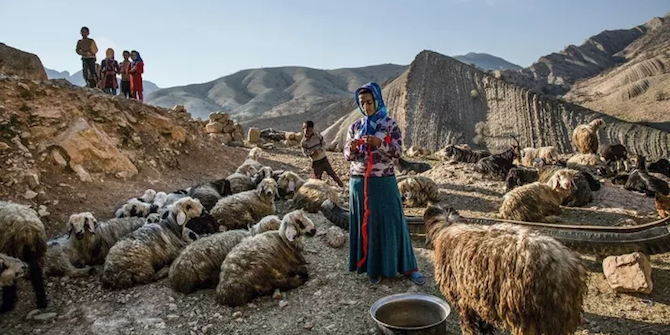by Andrew Gardner, University of Puget Sound
This memo was presented part of a workshop organised by the LSE Middle East Centre on 13 June 2018, looking at Tribe and State in the Middle East.

The scholarly conversation about tribes and tribalism has been an integral feature of social anthropology since its nascence in the nineteenth century. Lewis Henry Morgan, one of anthropology’s founding fathers, delineated tribes as social forms “individualized by name, by a separate dialect, by a sovereign government and by the possession of a territory which it occupies and defends as its own.” Culled from his assessment of a constellation of different native North American groups and, particularly, through his closer interactions with the Iroquois Federation, Morgan’s definitional components recurred in the twentieth century as the ethnographic gaze incorporated the peoples of colonial Africa, of the Middle East, of Near-eastern Asia, of the arctic fringe, and elsewhere.
While these core features persevered in anthropology’s estimation of tribalism in the twentieth century, shorn from this definition was the social evolutionary framework that fuelled anthropology’s conception and shaped initial understandings of tribalism. With the exception of the neo-evolutionists of the mid-twentieth century, anthropologists largely abandoned the social evolutionary framework that posited tribalism as a waypoint on a unilinear trajectory toward a civilization. Although anthropology maintains a vague inclination to continue framing tribalism as a mode of organization with a global, universal and historical footprint, conversations nowadays are more commonly delimited by geographical region. It would be unusual, for example, for a contemporary anthropologist to venture an ethnological thesis about the organizational parallels between the San of Mozambique, the S’Klallam of the northwestern reaches of the United States, and the Harb of Saudi Arabia.
The baggage of anthropology’s abandoned preoccupation with a social evolutionary framework nonetheless reverberates into the contemporary era. Tribalism retains a connotation of primitiveness, and it continues to be framed as a social form antithetical to modernity or otherwise problematic to development. Sultan al-Qassemi, for example, concludes his essay on contemporary Arabian tribalism with the note that the Arabian states should take care not to, “stoke the flames of tribalism … if they truly intend to build a modern civil state.” His (and many others’) sentiments perhaps reinforce connotations of tribalism’s primitiveness, but they more assuredly illuminate an enduring set of questions that connect anthropology’s scholarly past with our present moment: what is the political role of contemporary tribes, how does this social form relate to the state, and can those two forms of belonging coexist?
There is more that we might salvage from anthropology’s long assessment of tribe as a social form. We might also purchase anthropology’s assertion that tribalism, recognized as the segmentary lineage system, is a form of political and social organization frequently interwoven with arid environments and, more precisely, oftentimes tied to pastoral nomadism as a mode of production. In Arabia, agriculture was mostly impossible in the pre-modern era, and sedentarization was prohibitively challenging for much of human history. In such environs, pastoral nomadism comprised one of the only viable modes of production for human survival. The segmentary logic of tribalism was ideally configured to weld together a population dispersed over vast tracts of land and who, as a result, may encounter one another only sporadically or seasonally. In this dispersed existence, kinship, genealogy, and ancestry allow individuals to socially place almost anyone they encounter, and to maintain asabiya — the felt sense of belonging that Ibn Khaldun described of tribalism long ago — with others one might encounter.
Additionally, and with plenty of evidentiary support in the ethnographic canon, we might salvage ethnographers’ longstanding assertion concerning that malleability and flexibility of tribal belonging, despite the seemingly ascribed nature of this calculation of human relations. The ethnographic canon is littered with examples of ambiguities and genealogical slippages, with recurring assertions about the flexibility in the delineation of tribal belonging, with descriptions of the formation of new tribes where previously absent, and more broadly, with discussions of the recurring artifice lurking within tribalism’s purportedly consanguineal calculation of belonging. For example, in some detail Al-Mohammad portrays the process of new tribes coalescing in Basra amidst the chaotic aftermath of the U.S.-led invasion of 2003. And in my own collaborative previous work, I assessed the emergence of extended family groupings as new tribes in contemporary Qatar. Donald Cole pointed to this same flexibility in his seminal ethnographic work amongst the Al Murrah, and the very same flexibility plagues calculations of tribal belonging on other continents.
In conclusion, then, what does this sojourn through the history of anthropology’s concern with tribalism suggest for scholarship moving forward?
Foremost, I think it posits tribe and tribalism as an important feature on the palette from which individual and collective identities are constructed, both in the Middle East and elsewhere. The malleability and flexibility of tribal belonging ensure its ongoing vitality. My own observations in the Gulf reinforce Al-Mohammed’s conviction that, “tribalism most certainly is not the defining matrix or grounding coordinates of how people live their lives and attempt to come to terms with and take a stand on their particular predicaments.” Rather, it is one aspect on a diverse palette of options from which many Gulf peoples construct their individual and collective identities in the contemporary era.
Second, from the sustained anthropological conversation concerning tribalism, I think we ought not to relinquish the materialist fabric of explanation that has long underpinned scholarly assessment of this social form. Indeed, this is the aspect of Lewis Henry Morgan’s seminal assessment of tribalism that caught the attention of Marx and Engels. That paradigmatic frame pins tribalism, as a social and political form, to collective survival in the arid environs of the Saharan belt. In the twentieth century, the material conditions underpinning Arabian tribalism vanished for most denizens of the peninsula, but I suggest that the framework remains relevant. The research question has merely shifted underfoot: amidst the rapid modernization and urbanization of the Arabian states in the twentieth century, what material conditions and circumstances now enable and foster this mode of belonging?
In Basra, Al-Mohammad ties the resurgence of tribalism to the absence of the state — tribalism is a coping strategy, culled from the traditions of the region, and useful in the contemporary terrain for survival and for aggrandizing social power. This is perhaps the most frequently encountered empirical scenario: people turn or return to the tribe in the absence of the state. Conversely, however, in both my own work and in miriam cooke’s work in Qatar, we chart the resurgence of tribalism amidst the expanding extrapolation of the state apparatus. Speculative explanations for this conundrum point to the exclusivity of tribalism in the Gulf Peninsula — against the backdrop of a sea of foreigners, tribalism provides a mode of belonging to which only citizens can belong. Emirati scholar Sultan al-Qassemi further suggests tribe as a mode of belonging essential to authoritarian sovereignty in Arabia, in that ruling families frame their legitimacy in tribal discourse. Other explanations point to the social topography of the rentier state, and the role that tribes play in aggrandizing resources in that context.
In my explication of the segmentary lineage system to students over the years, I’ve often noted that this mode of belonging is strikingly foreign to westerners, in that tribes comprise a social stratum occupying the identity-space between the nuclear family and national belonging. In America, that stratum has been largely empty for much of history. But in the contemporary American moment, that previously empty space is suddenly busy with contentions and assertions about ethnic forms of belonging and their primacy. It’s a strange parallel that the resurgence of tribalism in Arabia resembles (and predates) the social factionalization that characterizes contemporary America.
Andrew Gardner is Professor of Anthropology at the University of Puget Sound. His scholarship focuses on the Gulf States of the Arabian Peninsula, and his books include Constructing Qatar: Migrant Narratives from the Margins of the Global System and City of Strangers: Gulf Migration and the Indian Community in Bahrain.
Other posts in this Series:
- Introduction by Courtney Freer
- Tribalism in Middle Eastern States: A Twenty-first Century Anachronism? by Richard Tapper
- Tribe and State in the Contemporary Arabian Peninsula by J. E. Peterson
- The Syrian Civil War: What Role do Tribal Loyalties Play? by Haian Dukhan
- Tribes and Tribalism in a Neoliberal Jordan by Jessica Watkins
- From Revolutions to Elections: When Tribes Transform State Power by Alice Wilson
- The Political Decline and Social Rise of Tribal Identity in the GCC by Steffen Hertog
- Tribal Modern: Branding New Nations in the Gulf by miriam cooke
- Gulf Nationalism and Invented Traditions by Natalie Koch
- Tribal Social Evolution and Gender: Conflict in Urbanized Tribal Units by Alanoud Alsharekh
- Tribal Revival in the Gulf: A Trojan Horse or a Threat to National Identities? by Maryam Al-Kuwari







1 Comments